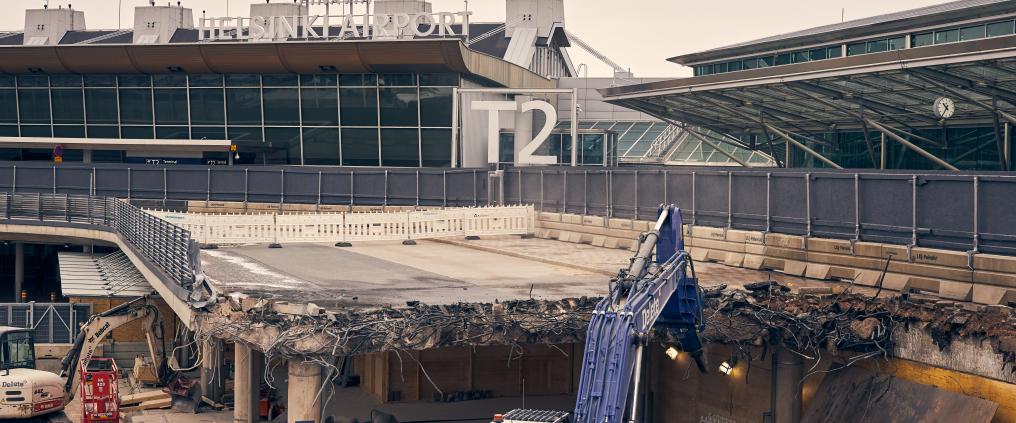Last year, a massive construction site in front of Helsinki Airport has covered an area equivalent to nearly three Esplanadi parks in Helsinki. In the early 2020s, this site will host an entirely new terminal entrance hall with air passengers’ check-in, security control, baggage drop and areas for arriving passengers.
The renewal is part of the largest construction project in the airport’s history. During 2019, expansions of Helsinki Airport’s non-Schengen area have been taken into use piece by piece. Now, construction work has shifted towards the transformation of the area in front of Terminal 2.
“Large-scale demolition works in front of the terminal have been necessary for the construction the new entrance and arrivals and departure halls,” says Tuomo Lindstedt, Project Manager at Finavia who manages the expansion and alteration process.
Once the new expansion is ready, the current arrivals and departure halls in Terminal 2 will become part of the gate area for Schengen flights.
The frame of a new parking building soon completed
“We have demolished the old P1/P2 parking hall and the previous car ramps for dropping off passengers,” Lindstedt says.
The construction of the new P2 parking hall has also begun with excavation works and building the foundation. The new parking hall with 1,800 parking spaces will be taken into use in late 2020.
“We have currently installed 80 % of the building frame, and our goal is to have the framing work completed by the end of the year 2019. After this, our work will continue with ventilation, lighting, elevators, surfaces and the parking system,” Lindstedt continues.
The construction of the parking hall has proceeded smoothly.
“We are well on schedule. In a project of this scale, proceeding from the first planning stages to taking the first new premises into use in four years is quite fast,” he says.
Biggest changes in traffic arrangements are over
For passengers at Helsinki Airport, the demolition and construction works have brought changes to paths and passages, as well as locations of bus and taxi zones.
“The traffic arrangements have been a big push for us. The project with its 39 subprojects has been carried out in phases so that in front of the terminal, walking routes, bus and taxi traffic, goods transportation and passenger drop-off have been able to continue at all times,” Lindstedt says.
The work has been planned so that there is as little nuisance as possible for airport operations. The goal has been to avoid short-term arrangements that would mean continuous changes for passengers.
“The phasing period started in January 2019, and in August the construction site was permanently separated from passenger traffic and airport operations in the terminal. The current pathways and areas for different forms of transportation are in place until the new permanent locations will be taken into use when the expansion is completed,” says Lindstedt.
The alliance model makes execution more flexible
The excavation work for the new arrivals and departure hall is well underway and the piling work is mostly completed.
“The first elevator and technical shafts and frame pillars have been cast, and our goal is to have the building frame reach its full height in late 2020,” says Lindstedt.
The transformation project in front of Terminal 2 is carried out in an alliance model. The operator Finavia, contractor SRV, and planning partners ALA Architects, Arkkitehtitoimisto HKP and Ramboll Finland all work under a shared contract.
“Construction work in the busy airport environment means we have to endure pressure and be ready for changing plans. There will be plenty of things to coordinate, especially when the newly constructed area will be integrated into the existing terminal building where the airport is fully operating”, Lindstedt explains.
With good planning and cooperation, construction brings as little disturbance as possible for passengers.
“We have been planning the solutions together from the start, and our partners can usually already predict how possible changes will affect the plans. The most important thing is that travelling at Helsinki Airport remains smooth under all circumstances,” says Lindstedt.



